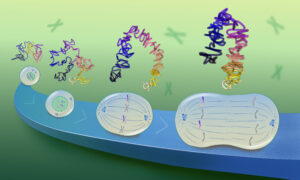This project has received funding from the European Union’s Horizon 2020 research and innovation program under the Marie Skłodowska-Curie grant agreement No. 945405
Making in situ serial crystallography more accessible
EMBL Grenoble Fellow Nicolas Foos explains the benefits of a new method developed by EMBL and the ESRF – a project he led during his ARISE fellowship

Scientists at EMBL Grenoble and the European Synchrotron Radiation Facility (ESRF) have developed a new method for using in situ serial crystallography (iSX) to study the structure of macromolecules. They recently described this new technique in a paper published in the journal IUCrJ. The method is now operational at the ID23-2 beamline, jointly operated by EMBL and the ESRF.
Nicolas Foos, the first author of this publication, was part of the first generation of ARISE fellows – a programme designed to support the development of new technologies and methods in life sciences and train scientists in research infrastructure management.
After completing his PhD in biochemistry and molecular biology at the Université de Marseille, France, Foos gained experience through postdoctoral positions at the SOLEIL and ESRF synchrotrons. In 2021, he joined the McCarthy team at EMBL Grenoble as part of the three-year ARISE programme to focus on developing methods and instrumentation for macromolecular crystallography. In this interview, he talks about this new method and the ARISE fellowship programme.
What are the main features of this new method for using in situ serial crystallography?
The main feature of the method is that it works directly from the crystallisation plate. A crystallisation plate can have an average of 96 wells (very small holes), each containing three tiny drops of crystallised protein. Harvesting these crystals to find just a few good ones – which is the regular approach – is tedious and time-consuming. Instead of harvesting only the ‘best-looking’ crystals, in situ experiments consist of screening them directly in the crystallisation plate and getting the data from there. However, this type of experiment was not seen as an accessible method for everyday use.
To make this simple and efficient, we developed a new method relying on a micro-diffractometer combined with a plate holder accommodating SBS-96 plates. These instruments offer excellent technical performance in terms of movement and accuracy of data collection, which is key to the quality of the final data.
Once you have the right tools, you need the appropriate interface to use them in the best possible way. To ensure a reliable, precise, and well-controlled method, we developed a user interface adapted to the user’s needs. This has been an important aspect of our work.
What are the advantages of this new method for structural biology?
The main advantage is that it creates a shortcut in the usual structure determination workflow. Our new method makes in situ experiments straightforward and efficient. This will ultimately reduce the cost and time needed for structure determination, especially for challenging projects.
It’s also a great approach for drug discovery projects. Screening compounds directly in the plate will be easier and allow experiments to be carried out at room temperature – which is extremely important for studying targets in their natural and flexible state. This will improve the quality and reliability of the final output.
Taking this a step further, we are also opening up new opportunities for even more automated experimental workflows. We may soon see the development of a ‘From the plate to the 3D model’ pipeline, without human intervention – which I believe should be the ultimate goal.
My objective in applying for the ARISE fellowship was to make crystallography more accessible to a larger number of scientists, even non-experts, envisioning that X-ray crystallography would become a popular tool in the larger ‘integrative biology’ toolbox. I believe this method is one more step in this direction.
What did you enjoy most in the ARISE programme?
The ARISE fellowship programme offers excellent training from day one. When applying for the fellowship, it is essential to define all the aspects of your project in detail, from the scientific and technical aspects to addressing specific bottlenecks, the people you would collaborate with, and how you would communicate your project.
A unique feature of this programme is also the mandatory secondments, with secured time to work in a partner organisation, other EMBL teams, or service provision facilities. During my three-year ARISE fellowship, I worked closely with the ESRF and experienced working with ARINAX – the company that commercialises EMBL Grenoble’s instrument prototypes worldwide and ALPX – EMBL Grenoble’s spin-off that provides crystallography services to the pharmaceutical and biotech industries.
ARISE is an excellent option for people who, like me, enjoy working in a multidisciplinary field. The programme is aimed at people who either have a strong scientific background but are also interested in technical or methodological aspects, or who are coming from a technical domain and want to imagine and create new solutions to support high-level scientific projects. This approach allows for bridging between people, academic research, and industrial companies. Creating permeability is the whole strength of the ARISE programme.
I also benefited a lot from a great mentor who supported me during my career development, and from the ARISE community. ARISE brings together a unique and diverse group of fellows, with a unique sense of cooperation and mutual support. The dedication and quality of exchange to support each other have been unbelievable.
Source article(s)
In situ serial crystallography facilities 96-well plate structural analysis at low symmetry
IUCrJ 15 July 2024
10.1107/S2052252524005785



